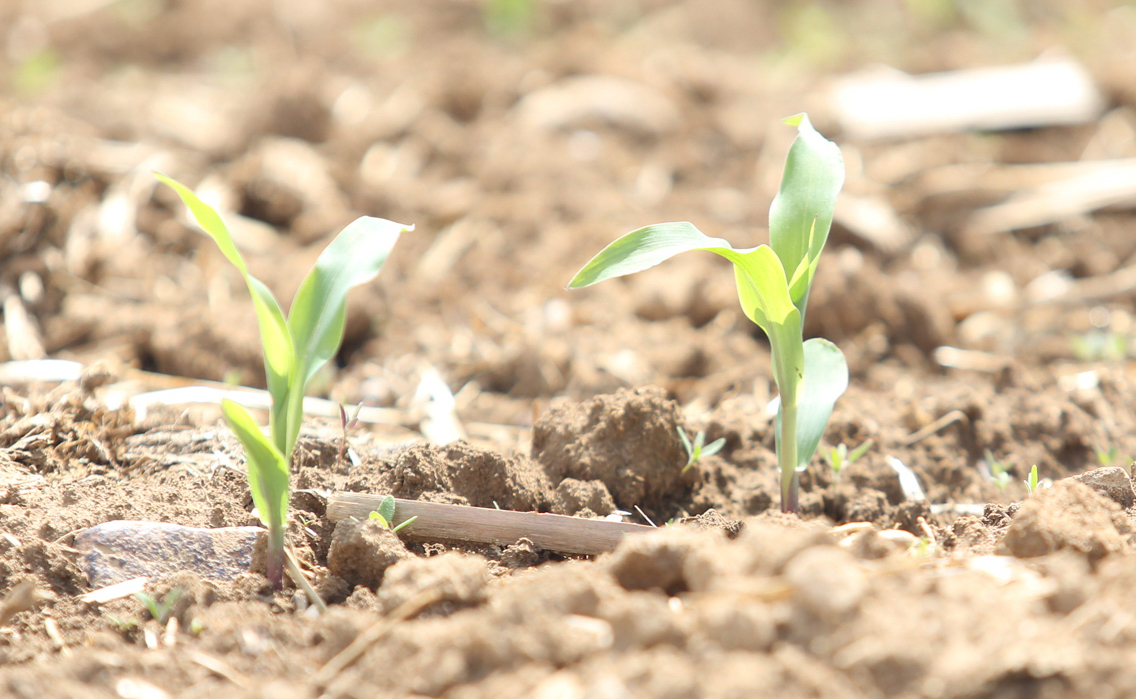Getting Germination Off to a Good Start

The key to higher yield potential is to limit as many stresses as we can while maximizing the length of time that our hybrids have to collect sunlight and turn that energy into sugars to fill the grain. This practice has pushed our planting window earlier and earlier in the season. And this year, planting is starting in cold, wet soils, which can cause stress during the germination process. In order to reduce these stresses, it’s critical to understand the germination process. Four main steps are required to start germination.
Step 1: The seed must be rehydrated
This process usually occurs in 24 to 48 hours, and the goal is to raise the moisture from around 13% to 32–34% to start the germination process. This 24- to 48-hour window is absolutely critical to even emergence, and the key is that the water must be above 50 degrees in order not to cause germination issues. If soil temperatures fall below 50 degrees or we get a cold wet rain below 50 degrees, the corn plant’s germination can be negatively affected.
Once the seed starts to take in water, it will begin producing gibberellic acid, which is a plant hormone that stimulates the production of sugars from starches. This conversion is what supplies the seedling with the sugars that it needs to grow.
Step 2: The seed must take up phosphorus
Phosphorus is used in energy transfer and DNA production, so it is essential to early season plant growth. Once the starches in the seed have converted to sugars, the sugars must be broken down to provide energy to the plant. As the sugars break down, phosphorus is used to transfer energy to the parts of the plant that need it for cell elongation and growth.
Step 3: The seed must take up zinc
Zinc is also used in the conversion of starches to sugars. More importantly, it is used in the production of auxins within the plant. Auxins are plant growth hormones that cause cells to elongate and divide, and they stimulate the above-ground growth of the plant.
Step 4: The seed must produce cytokinins
Cytokinins are another plant hormone that stimulates cell division and differentiation. They cause the roots and shoots to elongate and grow. Without cytokinins, the plant cells would have no signal to replicate, divide and differentiate into separate parts of the plant.
Support early, strong germination during cold, wet weather
In cold, wet soils, these four steps will occur much more slowly, putting stress on the plant. Anything farmers can do to help the germination process will lead to a better, more robust stand and, therefore, higher yield potential.
Step 1: The seed must be rehydrated
This process usually occurs in 24 to 48 hours, and the goal is to raise the moisture from around 13% to 32–34% to start the germination process. This 24- to 48-hour window is absolutely critical to even emergence, and the key is that the water must be above 50 degrees in order not to cause germination issues. If soil temperatures fall below 50 degrees or we get a cold wet rain below 50 degrees, the corn plant’s germination can be negatively affected.
Once the seed starts to take in water, it will begin producing gibberellic acid, which is a plant hormone that stimulates the production of sugars from starches. This conversion is what supplies the seedling with the sugars that it needs to grow.
Step 2: The seed must take up phosphorus
Phosphorus is used in energy transfer and DNA production, so it is essential to early season plant growth. Once the starches in the seed have converted to sugars, the sugars must be broken down to provide energy to the plant. As the sugars break down, phosphorus is used to transfer energy to the parts of the plant that need it for cell elongation and growth.
Step 3: The seed must take up zinc
Zinc is also used in the conversion of starches to sugars. More importantly, it is used in the production of auxins within the plant. Auxins are plant growth hormones that cause cells to elongate and divide, and they stimulate the above-ground growth of the plant.
Step 4: The seed must produce cytokinins
Cytokinins are another plant hormone that stimulates cell division and differentiation. They cause the roots and shoots to elongate and grow. Without cytokinins, the plant cells would have no signal to replicate, divide and differentiate into separate parts of the plant.
Support early, strong germination during cold, wet weather
In cold, wet soils, these four steps will occur much more slowly, putting stress on the plant. Anything farmers can do to help the germination process will lead to a better, more robust stand and, therefore, higher yield potential.
- Select in-furrow starters with phosphorus to give an added boost to this germination process by providing phosphorus to the plant right when it needs it.
- Add chelated zinc, and a plant growth regulator like Ascend® SL PGR in addition to the starter fertilizer to help give the corn seed what it needs to germinate successfully, even in cold, wet soil conditions.
- Make sure in-furrow zinc is fully chelated, because zinc can very quickly bind to the soil —especially in high pH soils. A fully chelated zinc like Ultra Che® Zinc 9% is important to making sure enough zinc is available to a young corn seedling.
- Use plant growth regulators that contain cytokinins, auxins and gibberellic acid to speed up the germination process — that way the seed doesn’t have to produce as much of these compounds on its own. Ascend® plant growth regulators have the ideal concentration of each of these hormones to speed up germination, and help the corn plant come out of the ground faster.


